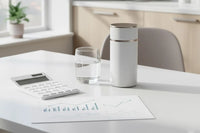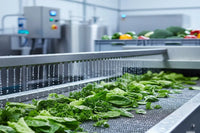In food processing, pathogens are the invisible enemy—relentless, adaptable, and ever-present. They don’t care about your throughput targets. They don’t respect your audits or your HACCP logs. They wait for the moment your sanitation protocol slips… and then they strike.
Listeria monocytogenes.
Escherichia coli.
Salmonella enterica.
Three names that have haunted the food industry for decades. Behind each one lies a trail of illness, lawsuits, lost contracts, and national recalls.
So let’s ask the only question that matters:
What truly destroys them?
And more importantly: what destroys them without creating new risks, costs, or chemical exposure for your team or your product?
The answer is clear. And it’s already being used by USDA plants, seafood processors, cruise lines, and hospitals across the country.
It’s called hypochlorous acid (HOCl)—and it’s changing everything.
The Science of Pathogen Destruction: Why HOCl Hits Harder, Faster, and Safer
HOCl is not some synthetic chemical concoction. It’s a naturally occurring molecule, created by white blood cells in the human immune system to kill invading bacteria and viruses.
Modern technology has made it possible to replicate this molecule at scale—using just salt, water, and electricity through a process called electrolysis.
What you get is a pH-neutral disinfectant that kills nearly every known foodborne pathogen on contact, without the toxic aftermath of bleach, quats, or chlorine dioxide.
Here’s the kicker: it’s 100x more effective than sodium hypochlorite (bleach) at the same concentration—and doesn’t require a rinse.
Meet the Kill List: HOCl vs. the Big Three Pathogens
🦠 1. Listeria monocytogenes
Why it’s deadly: Listeria is resilient. It forms biofilms. It survives cold. And it thrives in damp processing environments like RTE rooms, seafood lines, and produce wash stations.
Why bleach fails: Bleach has limited penetration through biofilms and quickly loses effectiveness when organic material is present.
What HOCl does: HOCl penetrates biofilms, oxidizes cellular membranes, and kills Listeria within seconds. It can be fogged into the air or sprayed directly onto surfaces, with no post-rinse required.
Result: USDA plants using HOCl fogging have reduced surface Listeria counts by over 90% and passed third-party environmental swab audits without corrective actions.
🧫 2. Escherichia coli O157:H7
Why it’s dangerous: A single cell of E. coli O157 can cause severe illness or kidney failure. It’s especially dangerous in raw meat, produce, and dairy.
Why traditional sanitizers struggle: E. coli can hide in microscopic crevices and survive rinse cycles.
What HOCl does: HOCl disrupts E. coli’s outer membrane instantly. It’s small enough to reach into cracks and kill organisms other sanitizers miss.
In field tests, EcoloxTech HOCl systems eliminated 99.999% of E. coli from conveyor belts, cutting down contamination risk without the need for surface soaking or chemical dwell time.
🧬 3. Salmonella enterica
Why it’s prevalent: Found in poultry, eggs, meat, and produce. Salmonella is responsible for over 1 million foodborne illnesses annually in the U.S. alone.
Why rinse cycles fall short: Salmonella is often embedded in organic matter or surface films, where bleach is neutralized before it can act.
What HOCl does: Because it doesn’t require post-rinse, HOCl can be left to air-dry on surfaces, offering extended protection. It oxidizes Salmonella’s DNA and protein structures within seconds.
In third-party lab studies, HOCl eliminated over 5 log reduction of Salmonella on stainless steel, plastic, and conveyor surfaces—without corrosion or residue.
The Secret Is in the Charge
Chemically speaking, HOCl is neutral. That means it’s more likely to penetrate pathogen cell walls than bleach (which is negatively charged and repelled by bacterial membranes).
Once inside, HOCl oxidizes critical enzymes and DNA, killing the organism with surgical precision—without leaving behind chemical residue.
That’s why hospitals use it. That’s why the USDA allows it. That’s why you should, too.
No Rinse. No Residue. No Excuses.
Traditional sanitizers require a rinse not because of ineffectiveness—but because of their danger.
- Bleach causes respiratory damage.
- Chlorine dioxide produces toxic off-gas.
- Quats aren’t approved for direct food contact.
- Ozone is unstable and expensive.
With HOCl, you can fog an RTE room, spray a fish filet, or dip leafy greens—with no rinse, no gloves, and no delays.
And because it leaves no residue, there’s no chemical interaction with your product. Flavor, aroma, color, texture—preserved exactly as it should be.
Compliance Backed. Lab Verified.
Let’s be clear: HOCl isn’t some fringe tech or greenwashing gimmick.
- ✅ USDA FSIS approved for food contact surfaces
- ✅ FDA GRAS for direct produce and meat contact
- ✅ EPA List N and K listed
- ✅ NSF D2 certified
- ✅ Used by Norwegian Cruise Lines, St. James Smokehouse, and multiple top-50 poultry and seafood processors
Whether you’re prepping for a third-party SQF audit or a surprise FSIS inspection, HOCl lets you walk the floor with confidence—and clean air.
Bonus Kill Power: Beyond the Big Three
HOCl doesn’t stop at the usual suspects. It’s also proven to eliminate:
- Norovirus (Category A virus, highly resistant)
- Campylobacter (linked to poultry)
- Mold and mildew spores
- Yeast and spoilage bacteria
- COVID-19 and other airborne respiratory viruses
This makes it uniquely suited for cross-contamination zones, foggable applications, and sanitation between shifts—without downtime.
Real Facilities. Real Results.
- ✅ A salmon processing plant in the Pacific Northwest reduced ATP counts by 80% within two weeks of switching to HOCl, while simultaneously cutting rinse water usage by 50%.
- ✅ A New Jersey RTE facility passed two consecutive GFSI audits with zero sanitation CAPAs after implementing HOCl fogging in all high-risk zones.
- ✅ A Midwest poultry plant replaced three chemicals (quat, bleach, peracetic acid) with a single HOCl generator—reducing sanitation chemical spend by $11,000/month.
Conclusion: Don’t Just Sanitize. Eliminate.
In food safety, the enemy doesn’t knock. It infiltrates. It waits.
And when it hits, bleach isn’t enough. Rinses aren’t fast enough. Your old protocols are too slow, too dangerous, and too reactive.
HOCl gives you the upper hand:
- 🔥 Instant kill
- 🌱 Zero residue
- 💧 No rinse
- 🧠 Total compliance
The kill list is clear. The science is settled. The transition is easy.
So why are you still using chemicals your own body would never produce?
Want the Lab Data and Full Pathogen Kill Protocol?
👉 Access our HOCl Compliance & Sanitation Resources:
- The full USDA/FDA/NSF compliance matrix
- HOCl pathogen kill charts and ppm guidelines
- Fogging and spray protocols by facility type
- ROI calculator and spec sheets
📩 Delivered instantly to your inbox. Free for food safety warriors.





